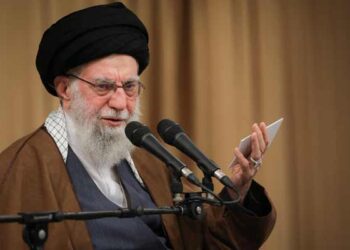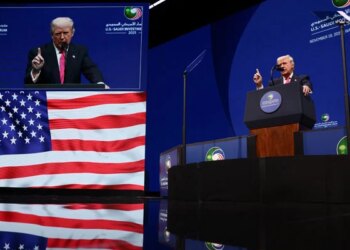Select Language:
Hamas has criticized Donald Trump, labeling him a racist, describing him as a “recipe for chaos,” and dismissing his vision for Gaza as absurd. However, a significant phone conversation last month appeared to sway Hamas’s view, suggesting they saw potential in the U.S. president’s influence over Israel to push for peace, even if Hamas agreed to release all its hostages, which it currently uses as leverage in Gaza.
During the widely covered call, Trump connected Israeli Prime Minister Benjamin Netanyahu with Qatar’s prime minister after a White House meeting in September. Trump apologized to Qatar for an Israeli strike on a residential complex in Doha that housed Hamas officials. Although the bombing did not kill any Hamas leaders, including senior negotiator Khalil al-Hayya, it gave Hamas new confidence that Trump could stand up to Netanyahu and was committed to ending the conflict in Gaza.
Following the signing of a ceasefire brokered by Trump on Wednesday, Hamas’s confidence in his commitments was reinforced, even though Trump earlier this year proposed policies such as expelling Palestinians from Gaza and transforming it into a US-controlled resort town.
Under the terms of the deal that went into effect Friday, Hamas agreed to release its hostages without securing agreement on a full Israeli withdrawal. Two Hamas officials admitted this was a risky move that depended heavily on Trump’s personal commitment to prevent the deal from falling apart. Hamas leaders are acutely aware that their gamble could backfire, fearing that Israel might resume military operations after the hostages are freed, as happened after a ceasefire in January that Trump’s team also helped negotiate.
Despite these concerns, Hamas felt reassured enough by the presence of Trump’s close advisers and regional powerbrokers to sign the ceasefire, even as many of its core demands, including moves toward establishing a Palestinian state, remained unaddressed. Trump’s enthusiasm was palpable during the talks, with reports indicating he personally called multiple times while aides such as Jared Kushner and Steve Witkoff engaged with Israeli and Qatari negotiators.
While this process may pave the way to ending the October 7, 2023, Hamas attack that sparked the conflict, there is no guarantee that subsequent phases of Trump’s 20-point Gaza plan will be implemented. Nonetheless, Hamas’s negotiators gained confidence from Trump’s previous actions—such as the Qatar strikes and the June ceasefire that halted a 12-day Israeli war with Iran—believing he would not allow Israel to immediately resume fighting after the hostages are released.
Multiple sources, including Palestinian officials, Hamas members, and American officials, shared insights into the negotiations. These discussions also indicated that Trump’s frustration with Netanyahu over the Qatar strikes was being used to pressure Israel into accepting a framework for ending the Gaza conflict. Trump’s ties with Gulf states, notably Qatar, have been strong, and his public assurances—such as promising no further Israeli attacks on Qatar—boosted Hamas’s confidence that the ceasefire would hold.
Hamas also noted Trump’s public call for a halt to hostilities between Iran and Israel, including his order on Twitter for Israeli planes to “turn around and head home” during a planned attack on Iran in June. This demonstrated Trump’s willingness to enforce ceasefire commitments.
Negotiations historically faced hurdles, with disagreements over how quickly Israeli troops would withdraw and whether Hamas could gather and release hostages while Israel retained control of parts of Gaza. To break the deadlock, regional leaders, including Qatar’s prime minister, traveled to Sharm el-Sheikh, with U.S. envoys and aides joining the talks, which were further bolstered by Turkey’s involvement due to its close ties to Hamas and recent meetings with Trump.
Hamas has long maintained that it would only release hostages in exchange for a comprehensive Israeli withdrawal and a resolution to the conflict. Israel, in turn, insists that it will only cease fighting once all hostages are returned and Hamas is dismantled. Neither side has achieved these aims in full, leaving ongoing issues to be addressed in future negotiations.
An important turning point was mediators’ success in persuading Hamas that holding hostages might be detrimental, as it could erode support among global players and weaken its position. Despite lacking formal legal guarantees, Hamas has received verbal reassurances from the United States and regional mediators that Trump intends to uphold the deal and prevent Israel from resuming military operations once the hostages are freed.
Hamas leaders are aware that their decision involves risk. The previous attempt to release all hostages simultaneously, with Trump’s backing, fell apart when he demanded an immediate, unconditional release; the subsequent breakdown led to increased Palestinian casualties and ongoing hostilities. Nonetheless, the current negotiations seem more promising, with multiple regional and international players motivated to push for a durable ceasefire.
Trump’s upcoming Middle East visit, described as a strategic move by Egyptian President Abdel Fattah al-Sisi, is expected to reinforce the agreement’s implementation, even amid unresolved details. The overall atmosphere suggests a cautious hope that this round of talks could bring a meaningful halt to the Gaza conflict, contingent on continued regional and international support.







